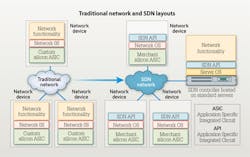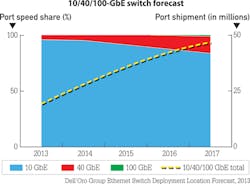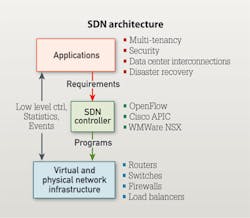From the August, 2014 Issue of Cabling Installation & Maintenance Magazine
Today's issue is not implementing SDN, but rather laying the groundwork for it over a 10-, 40- or even 100-Gbit Ethernet infrastructure.
By Frank Yang, CommScope
Software-defined networking (SDN) has been a hot topic in the network world for the past two years, yet many are not aware of what it is, what it can do, or its potential benefits. The greatest benefit of SDN is the potential savings on total cost of ownership for a network. The savings are only considered "potential" because SDN still needs more actual deployments and case-histories to prove its full cost-saving capability.
To explain how SDN works, we can start with a network device such as a router, switch or firewall. This device makes decisions of handling network traffic on its own, and such an individual decision-making approach may not be optimal. SDN transforms this traditional, discrete approach to a new holistic approach. SDN is a networking architecture that provides a capability to control or "define" network traffic flows, security policies, or network topology by dynamically programming network devices. The programming capability is centralized and hosted on one or a few standard servers known as an SDN controller. In brief, the SDN controller is the brain of SDN networks.
SDN is a recent development and still is in the early-adoption stage of its life cycle. Service providers or cloud providers are the early adopters. These adopters tend to integrate SDN with their cloud, enabling them to better control or shape their networks in a data center or across multiple data centers.
Bandwidth need
It is my belief that SDN requires a robust physical-layer (cabling) infrastructure. Whenever and wherever an SDN controller programs network devices to operate network traffic flows, the underlying connectivity must be available to support the operations. For example, if there is a large volume of data to be transferred across networks, the traditional approach requires the data to go through a firewall. However, a large volume of data passing through a firewall may significantly increase the workload of the firewall, thereby reducing the responses to other application requests. SDN can solve this problem by looking at the entire network, identifying a path, and creating a secure application to let the data bypass the firewall. This process is known as firewall cut-through. No matter which path SDN identifies to route data flows, the underlying connectivity must be up and available anywhere, at any time.
It is important to know that SDN relies heavily on a high-bandwidth and high-performance physical-layer infrastructure. SDN essentially is network virtualization, and a physical network device may be shared by multiple virtual networks. For example, SDN can slice a data center network for multi-tenancy operations. Each slice consumes a portion of the networking resource, but is presented logically as a complete, secured and isolated network for individual networking service; an example of such a service can be a private, public, or hybrid cloud. A high-bandwidth cabling infrastructure is needed to provision the necessary networking capacity shared by multi-tenants. A tenant can represent a networking service such as a cloud. The cloud basically is a service, and a high-performance cabling infrastructure is needed to guarantee cloud performance specified in the service level agreement.
To build the infrastructure for SDN, 10-, 40- or even 100-Gbit Ethernet is recommended. The 10/40/100-GbE not only provides high bandwidth, but also provides the low latency needed to achieve networking performance excellence.
Network users and industry analysts alike have been paying close attention to SDN. In the latest Global Enterprise Survey conducted by CommScope, 32 percent of respondents indicated that 40- and 100-GbE would have a significant impact on their future operations. In this vein, it makes sense for these users to look at an SDN solution to see how it may work into their respective IT strategies.
Additionally, a recent networking industry report published by Cleveland Research Company (www.cleveland-research.com) states that SDN does indeed create opportunities for 10-, 40-, and 100-GbE deployment. The Dell'Oro Group (www.delloro.com) reported that 10-GbE has been dominating Ethernet switch-port shipments in data centers since 2013. Dell'Oro also forecasted strong growth of 10-, 40-, and 100-GbE switch-port shipments in data centers, and SDN is a primary driver for this growth.
Virtualizing the network
As mentioned earlier, SDN is essentially defined as network virtualization. The architecture illustrated in this article features business-oriented applications or services communicating their requirements or needs to an SDN controller. The SDN controller is a set of network functionalities implemented in software and installed on one or more servers. The SDN controller then dynamically programs network traffic flows and/or topology of virtual network infrastructure according to business requirements.
When considering SDN, it is important to keep in mind the following two factors.
1. SDN specification-Several SDN definitions and specifications exist, such as vendor-specific or open-source specifications. They are not necessarily interoperable, but customers must thoroughly assess which one is suitable for their business requirements.
2. Underlying physical networking capacity and speeds-SDN architecture allows virtualization overlays to run on top of network infrastructure. Like server virtualization, it is possible and actually designed to have multiple virtual network devices running on top of physical network hardware, such as one switch or router.
SDN is architected to operate multiple layers of virtual networks over a pool of physical switches, routers, firewalls and load balancers. Additionally, virtual network overlays are dynamically programmed and created. They can be changed from time to time according to application requirements. It is recommended to provision the physical network hardware with high-enough bandwidth capacity so no bottleneck occurs when the network is being reprogrammed. 10-, 40-, and 100-GbE are the best standardized technologies available, providing high networking bandwidth capacity and the low latency needed to achieve networking performance excellence.
Frank Yang is manager, technologies and solution for CommScope's (www.commscope.com) enterprise data center market segment. This article is a compilation of two posts Frank contributed to The CommScope Blog.


